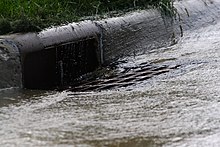Storm drain: Difference between revisions
→External links: rm advert |
|||
| Line 32: | Line 32: | ||
*[http://www.epa.gov/adopt/patch/html/guidelines.html U.S. EPA Storm Drain Stenciling Project Guidelines] |
*[http://www.epa.gov/adopt/patch/html/guidelines.html U.S. EPA Storm Drain Stenciling Project Guidelines] |
||
*[http://www.lastormwater.org/Siteorg/general/lastrmdrn.htm Los Angeles storm drain system] |
*[http://www.lastormwater.org/Siteorg/general/lastrmdrn.htm Los Angeles storm drain system] |
||
*[http://www.jrsmith.com United States storm drain and drainage systems] |
|||
*[http://www.glgi.org/mediawiki/index.php?title=7_Simple_Steps_to_Clean_Water 7 Steps to Clean Water] from Great Lakes Green Initiative |
*[http://www.glgi.org/mediawiki/index.php?title=7_Simple_Steps_to_Clean_Water 7 Steps to Clean Water] from Great Lakes Green Initiative |
||
Revision as of 16:12, 3 April 2008

A storm drain, storm sewer (U.S.), stormwater drain (Australia and New Zealand) or surface water system (UK) is designed to drain excess rain and ground water from paved streets, parking lots, sidewalks, and roofs. Storm drains vary in design from small residential dry wells to large municipal systems. They are present on most motorways, freeways and other busy roads, as well as towns in areas which experience heavy rainfall, flooding and coastal towns which experience regular storms.
Storm drains should be separate from sanitary sewers, though in some places the runoff from storm drains is subjected to sewage treatment when there is sufficient capacity to spare. In the U.S. these systems are called combined sewers. In these systems a sudden large rainfall that exceeds sewage treatment capacity will be allowed to overflow directly from the storm drains into receiving waters via structures called combined sewer overflows.[1]
Most drains have a single large exit at their point of discharge (often covered by a grate or a grating to prevent access by humans and exit by debris) into either a canal, river, lake, reservoir, sea or ocean and spread out into smaller branches as they move up into their catchment area.
Small storm drains may discharge into individual dry wells. Storm drains may be interconnected using slotted pipe, to make a larger dry well system. Storm drains may discharge into man-made excavations known as recharge basins.
Pipes can come in many different shapes (rectangular, square, bread loaf shaped, oval and, more commonly, circle) and have many different features (including waterfalls, stairways, balconies and pits for catching rubbish or Gross Pollutant Traps (GPTs). Several different materials can also be used, such as brick, concrete and even plastic in some cases.
Building codes vary greatly on the handling of storm drain runoff. New developments might be required to construct their own storm drain processing capacity for returning the runoff to the water table and bioswales may be required in sensitive ecological areas to protect the watershed.
An international subculture has grown up around the exploration of stormwater drains. Societies such as the Cave Clan regularly explore the drains underneath cities. This is commonly known as 'urban exploration', but is also known as 'draining' when in specific relation to storm drains.
Ancient history
Archaeological studies have revealed use of rather sophisticated stormwater runoff systems in ancient cultures. For example, in Minoan Crete approximately 4000 years before present, cities such as Phaistos were designed to have storm drains and channels to collect precipitation runoff. At Cretan Knossos storm drains include stone lined structures large enough for a man to crawl through.[2] Other examples of early civilisations with elements of stormwater drain systems include early people of Mainland Orkney such Gurness and the Brough of Birsay in Scotland.
References
- ^ U.S. Environmental Protection Agency, Washington, D.C. "Combined Sewer Overflow (CSO) Control Policy." Federal Register, 59 FR 18688. April 19, 1994.
- ^ C. Michael Hogan, Knossos fieldnotes, Modern Antiquarian (2007)
See also
External links
- Groundwater Foundation glossary - storm drain
- U.S. EPA - Combined Sewer Overflows
- U.S. EPA Permit Program - Stormwater Discharges From Municipal Separate Storm Sewer Systems
- U.S. EPA Storm Drain Stenciling Project Guidelines
- Los Angeles storm drain system
- 7 Steps to Clean Water from Great Lakes Green Initiative
Gallery
-
Storm sewer installation
-
Catch basin connection
-
inside of a large Reinforced concrete box storm drain



